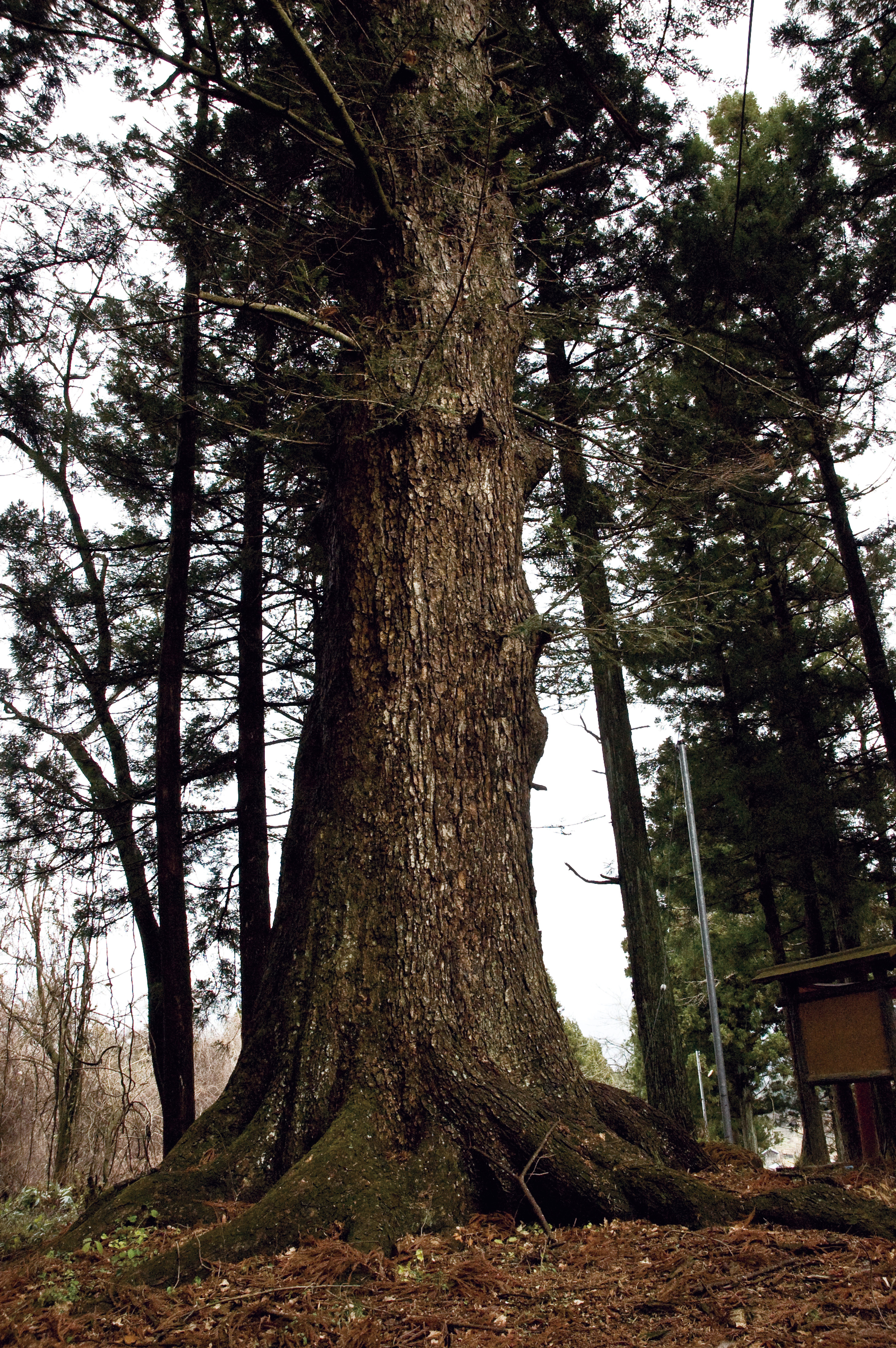館神社のモミ(Tate Shrine Japanese fir)


推定樹齢(Estimated Age) 400年(years)
幹周合計(Circumference) 6.10m
樹 高(Height) 28.00m
青森県最大級 Ranked among the largest in Aomori Prefecture
道仏地区館神社の前にあります。モミ(樅)はマツ科モミ属の常緑針葉樹です。日本のモミ属中、最も温暖地に分布し、その北端は青森県、南端は屋久島に達するといわれています。館神社の境内には、他にもケヤキなどの巨木が側に数本見られます。
現在「館神社」が建てられている場所にあったその館は、階上町道仏字館地内にあって、別に蝦夷館ともいわれ、通称館と呼ばれていました。
館は西からのびる段丘の先端部を人工的に掘り、土塁で切り、また道仏川が南側を西から東北に向かって流れていますが、これを掘代りとするなど、自然の地形を巧みに利用し構築しています。館がいつ頃築かれたかは不明ですが、伝承によると、館主である赤松民部吉時が天正19年(1591年)九戸放実の乱に南部信直に味方したため、九戸方の久慈備前、櫛引清長らに攻められ落城したと云われています。
館の形態、構造などこの地方にみられる中世城館の特色をよく遺しており、保存状態もよいことから文化財としても貴重です。
Tate Shrine and the Giant Japanese Fir
This massive Japanese Fir is located next to Tate Shrine in Dobutsu District. The fir is a member of the genus Abies in the family Pinaceae. Japanese firs are distributed across warmer regions. The northernmost area in which they are found is said to be Aomori Prefecture, with the southernmost being Yakushima Island in Kagoshima Prefecture. Along with this giant fir, the Tate Shrine grounds are also home to several other giant trees, including Japanese Zelkova.
Tate Jinja Shrine stands on the site of what was once Dobutsu Fort, built here over 500 years ago. Dobutsu Fort was a yakata, which is quite different from a typical castle. It was overseen by Akamatsu Yoshitoki, a retainer to the powerful Nambu family that once ruled part of present-day Aomori, Iwate, and Akita prefectures. The castle was attacked and destroyed in 1591 during the Kunohe Rebellion, a war of succession among the Nambu. While none of the original structures survive, the remnants of a moat can be seen on the outskirts of the shrine grounds. The entrance to the fort was located where the torii gate now stands.
Tate Jinja is dedicated to Hachiman, a Shinto deity of war, and the current building is the result of a reconstruction project that took place in 1981. The shrine hosts a large festival every year in late July.
The shrine is one of the designated sights along the Michinoku Coastal Trail, a long-distance walking course that passes through the nearby town of Hashikami. The gently sloping path that leads up to the shrine is flanked by tranquil rows of Japanese cedars (Cryptomeria japonica). The enormous Japanese fir (Abies firma) within the shrine’s precincts is one of the largest fir trees in Aomori Prefecture.
<簡体字>
馆神社
馆神社所在位置原本是一座道佛馆,建于500多年前。和典型的城堡不同,道佛馆是一座方形单郭的小城堡,它的主人赤松吉时是南部家族的一名家臣。今天的青森县、岩手县和秋田县的部分地区都曾是南部家族的领地。1591年,因南部家族继承人之争而爆发“九户政实之乱”,道佛馆在战乱中遭受攻击并被摧毁。尽管建筑早已不在,现在的神社外围还能看到护城河遗迹,如今鸟居矗立的位置正是当年城堡入口所在。
馆神社里祭祀的是八幡神,他是神道教的战神。现有的神社建筑是在1981年的一项重建工程中建造的。每年7月末,这里都会举办例大祭。
陆奥潮风步道从附近的阶上町穿过,馆神社是这条长线上的一大标志性景观。通往神社的缓坡两侧,日本柳杉(Cryptomeria japonica)高耸林立,安详宁静;神社内有棵巨大的日本冷杉(Abies firma),可谓青森县巨杉中的王者。
<繁体字>
館神社
館神社所在位置原本是一座道佛館,建於500多年前。和典型的城堡不同,道佛館是一座方形單郭的小城堡,它的主人赤松吉時是南部家族的一名家臣。今天的青森縣、岩手縣和秋田縣的部分地區都曾是南部家族的領地。1591年,因南部家族繼承人之爭而爆發「九戶政實之亂」,道佛館在戰亂中遭受攻擊並被摧毀。儘管建築早已不在,現在的神社週邊還能看到護城河遺跡,如今鳥居矗立的位置正是當年城堡入口所在。
館神社裡祭祀的是八幡神,祂是神道教的戰神。現有的神社建築是在1981年的一項重建工程中建造的。每年7月底,這裡都會舉辦例大祭。
陸奧潮風步道從附近的階上町穿過,館神社是這條長途步道上的一大標誌性景觀。通往神社的緩坡小徑兩側是一排排高聳林立的日本柳杉(Cryptomeria japonica),安詳寧靜;神社內有棵巨大的日本冷杉(Abies firma),可謂青森縣的巨杉之王。

地域観光資源の多言語解説整備支援事業



